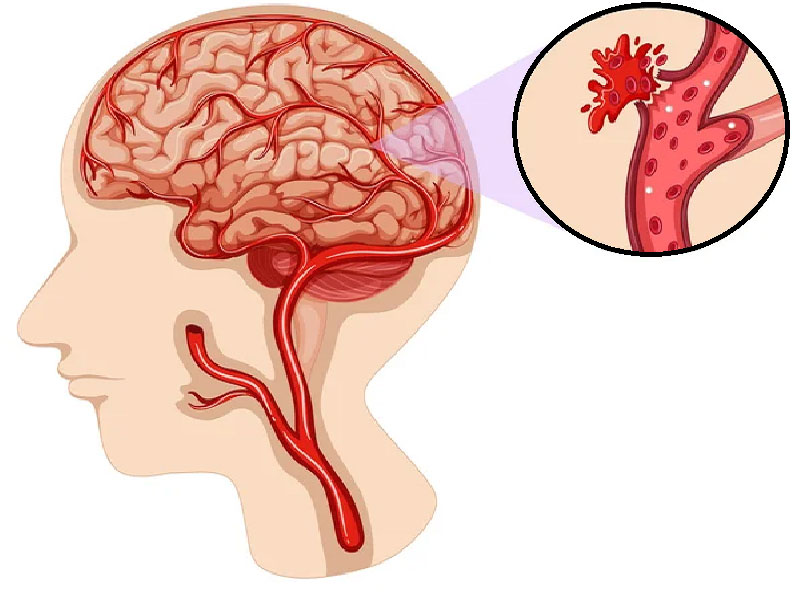Cerebral hemorrhage: What is it?
A cerebral hemorrhage is a serious, acute neurological condition that occurs when cerebral arterial vessels rupture, causing subsequent extravasation of blood into the brain tissue.
Cerebral hemorrhage can be classified as follows:
- Post-traumatic hemorrhage, which can occur after severe head trauma.
- Spontaneous hemorrhages, which occur in the absence of head trauma due to a variety of initially unidentified causes.
The different forms of brain bleed
Depending on the anatomical area in which the cerebral hemorrhage occurs, we can distinguish between:
- Extradural hematoma: the effusion is located between the bony vault and the meninges and is usually of traumatic origin after fractures.
- Subdural hematoma: the effusion occurs in the subdural space between the hard meninges and the brain and is caused by trauma or other causes.
- Intraparenchymal hematoma: hemorrhage within the brain parenchyma, usually secondary to spontaneous rupture of small vessels due to hypertension or other causes.
- Subarachnoid hemorrhage: involves the space between the arachnoid meninges and the brain tissue and results from the rupture of an arterial aneurysm.
- Intraventricular hemorrhage: when it affects the ventricular cavities.
It is a serious event that can be fatal in many cases if not treated promptly.
Causes of a cerebral hemorrhage
The most common causes of a brain bleed are
- High blood pressure: This is the most common cause of brain bleeding. High blood pressure can damage the walls of blood vessels, causing them to burst.
- Severe head trauma.
- Arteriovenous malformations (AVMs): AVMs are vascular tumors that can cause bleeding in the brain.
- Ruptured brain aneurysm: An aneurysm is an abnormal bulge in the wall of a blood vessel in the brain.
- Brain tumors can damage cerebral blood vessels.
- Improper use of blood thinners.
- DIC (disseminated intravascular coagulation): A severe and often fatal multisystemic syndrome characterized by synchronous thrombus formation and systemic bleeding in different organs.
Symptoms of a brain bleed
Symptoms of a brain bleed usually come on suddenly and can progress very quickly. They may vary depending on the severity and location of the hemorrhage.
The most common symptoms the patient may experience are:
- Sudden, severe headache
- Numbness or weakness in the face, arm, or leg, usually on one side of the body
- Difficulty speaking or understanding what others are saying (dysarthria or aphasia)
- Vomiting and nausea
- Problems with consciousness and bladder control
- Convulsions or seizures
- Hemiparesis or hemiplegia
- Sensory disturbances
- Coordination problems
The course of the disease may be complicated by:
- Seizures
- Respiratory irregularities
- Blood pressure instability or increase
- Abnormalities in body temperature that worsen the patient's prognosis
- The onset of cerebral edema, which can lead to neurological deterioration and even coma.
If you or someone you know has any of these symptoms, it is important to seek medical attention immediately. Early intervention can help reduce brain damage and improve the chances of recovery.
Treatment options for cerebral hemorrhage
Treatment of a brain bleed depends on the cause and severity of the hemorrhage. Initial treatment usually consists of stabilizing the patient and reducing intracranial pressure.
However, several steps must be followed to effectively treat a brain hemorrhage. First, a thorough medical evaluation should be performed to determine the cause and severity of the bleeding. Tests such as a computed tomography (CT) scan or magnetic resonance imaging (MRI) scan may be performed to visualize the extent of the bleeding.
The first step is to lower the intracranial pressure to prevent further brain damage. Medications such as corticosteroids may be given to reduce brain swelling.
In the most severe cases, when the hematoma is larger than 3 cm, surgery may be targeted. The neurosurgeon will perform endoscopic drainage, aspiration, or craniotomy to remove the hematoma and stop the bleeding.
After the patient is stabilized, rehabilitation may be required to help the patient regain brain function.









